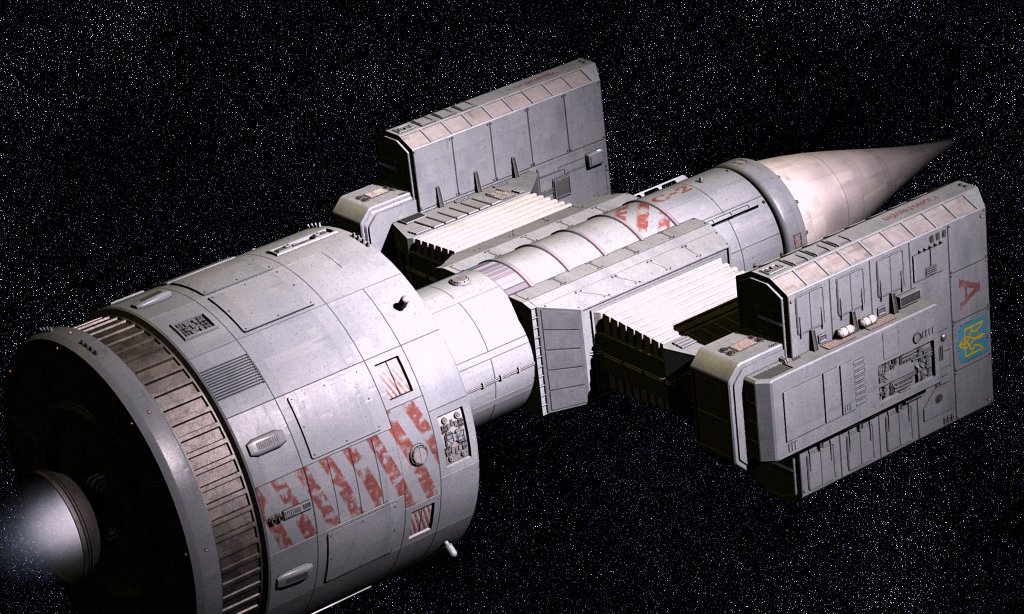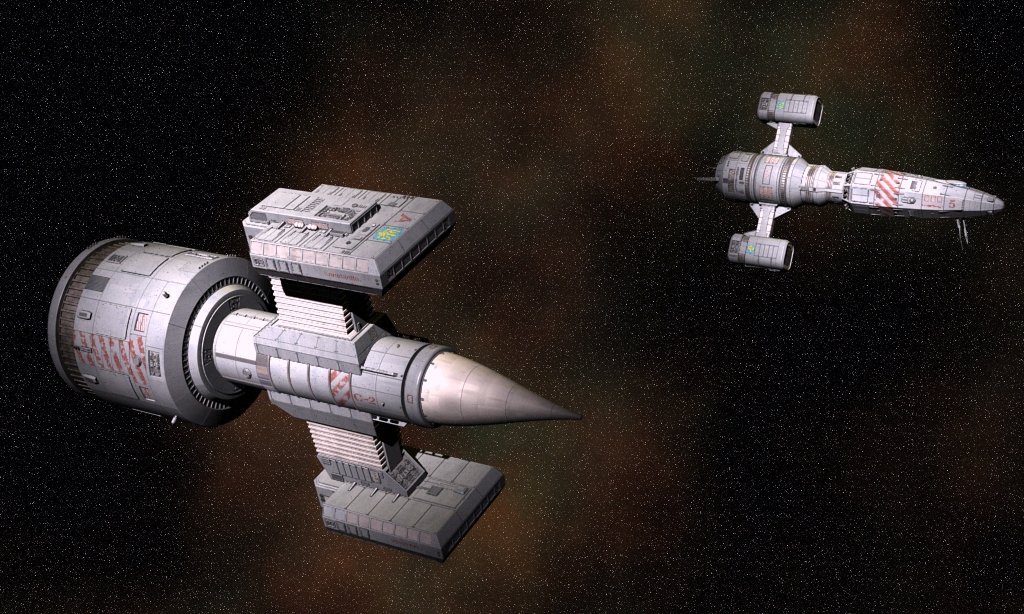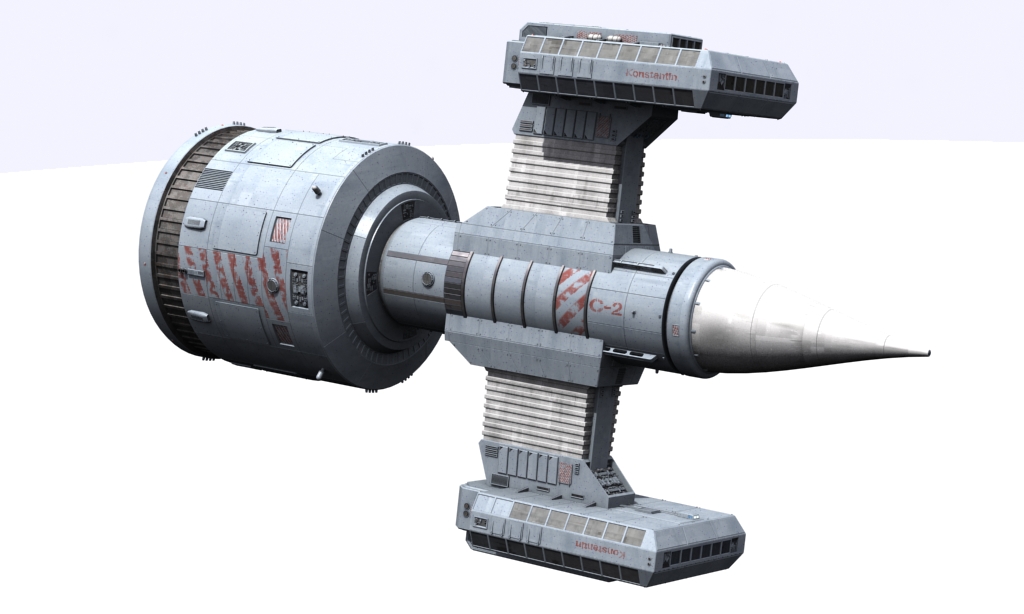KonstantineCommon European Space Agency CruiserBy Bryn Monnery, Laurent Esmiol, David Gillon and D Hebditch Introduction The Common European Space Agency Cruiser, or CESAC, followed on from the success of the pan-ESA Kiev Class Destroyers or CESADs. The CESACs were to be heavy combat warships a role they fulfilled more than competently for its time although it proved to be less capable of evolution than its lighter counterpart. Although superseded by more modern types in the service of first line powers they have served a glorious swansong with the Ukrainians at Eta Bootis. Acknowledgements The concept of the Konstantine as a common European design is by David Gillon. Artwork is by Laurent Esmiol.
Below: Konstantine and Jefferson on patrol in the Eta Bootis system early in 2300. |

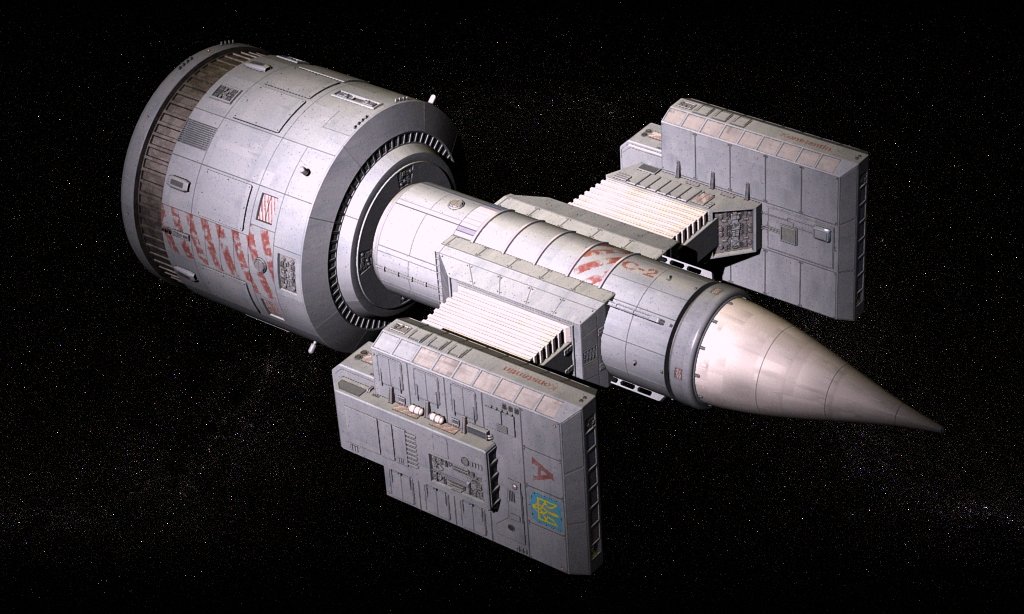
|
CESAC There
were five key design characteristics for the CESAC design, many of which
were shared with the . These were: -
Common
hull design using standard RT2 composite materials. Whilst the sections
had to be cast in a special facility they could be assembled in almost
any shipyard. -
Modular
approach to internal systems allowing individual nations room to customise
avionics, sensors and other systems. -
A
heavy missile armament to maximise long range firepower. A heavy laser
armament allowing excellent point defence and the capability to close
and overwhelm opponents at close range. -
Protection
in the form of hull armour and shields developed for the Ypres.
-
A
commonly produced drive system utilising a French Alsthom designed
200MW fission reactor and a purpose built Alsthom stutterwarp
drive. -
Elementary
force projection capability with up to 80 troops embarked and capability
to carry three small craft for short durations. Hull
design The
hull is composed of three distinct parts all of which are armoured. -
The
bow contains the operational systems of the ship. Including the bridge,
computers, TAC, sensors, stores, life support and weaponry. -
Spin
habitats which allow the ship to carry a significant number of crew
in addition to a med bay. It contains area of recreational space. -
The
bulbous stern contains the fission powerplant and the stutterwarp drive.
In addition the bulk of the engineering components and fuel is stored
here. The numerous engineering crew work from here. Overall
dimensions: -
Length:
85 m. -
Tonnage:
12500 tonnes Armament The
CESACs were initially produced with a very similar armament fit, although
later refits have meant that remaining CESACs can be armed with a wide
variety of weapons: -
18
x Guiscard LL-55 laser weapons mounted in masked turrets. -
9
x CESAM carried in three bays located in the bow with three remote piloting
stations. Electronics Sensor
systems are provided by Darlan Opto-Physique and were developed from those used on the CESAD
project. -
Active
with one working station: -
DSAP
S-2252. (Active: 10) -
Passive
with two working stations: -
DSMSP
S-2253T (Passive: 5) -
Standard
Navigation systems, Gravitational sensors, Deep system scanners. Engineering
Systems -
Power
Plant: Alsthom 200Mw fusion
reactor. -
Drive:
Alsthom Old Military 140MW stutterwarp drive. Crew The
CESAC has a total of 197 crew: -
22
in bridge -
23
in TAC -
30
in engineering -
7
in medical bay -
80
ship's troops (9 normal compliment) Living conditions in the CESAC are relatively spacious for a ship of this era, although it can become crowded when a full compliment of troops are embarked..
Below:
Size
comparison between the CESAC and the French Suffren Class Cruiser.
|
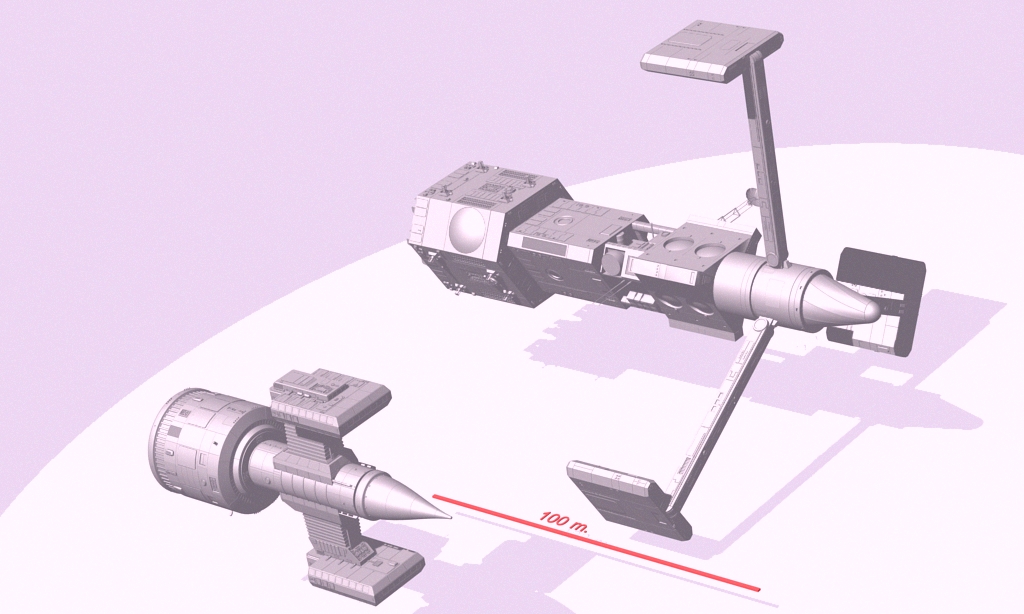
|
CESAC Warp
Efficiency: 3.21 Life
Support: 181 days (200 personnel), Comfort: 0, Price:
160 Mlv. Ship Status Sheet
Hits Bridge:
Captain, Helm, Navigator, 2 x Communications, 4 x Engineering, 2 x Computer. TAC:
Active Sensors, Passive Sensors, 18 x Fire Control, 3 x Remote Operators Hull
Hits: 68/34/17 Power
Plant Hits: 130/26 Damage
Control: 15 (5 teams Armament 9
CESAM with 3 datalinks. Below: The French crusier Orion operating in the Sol System during the War of German Reunification. Note the Ritage 1 tubes retro-fitted to the rear hull. |
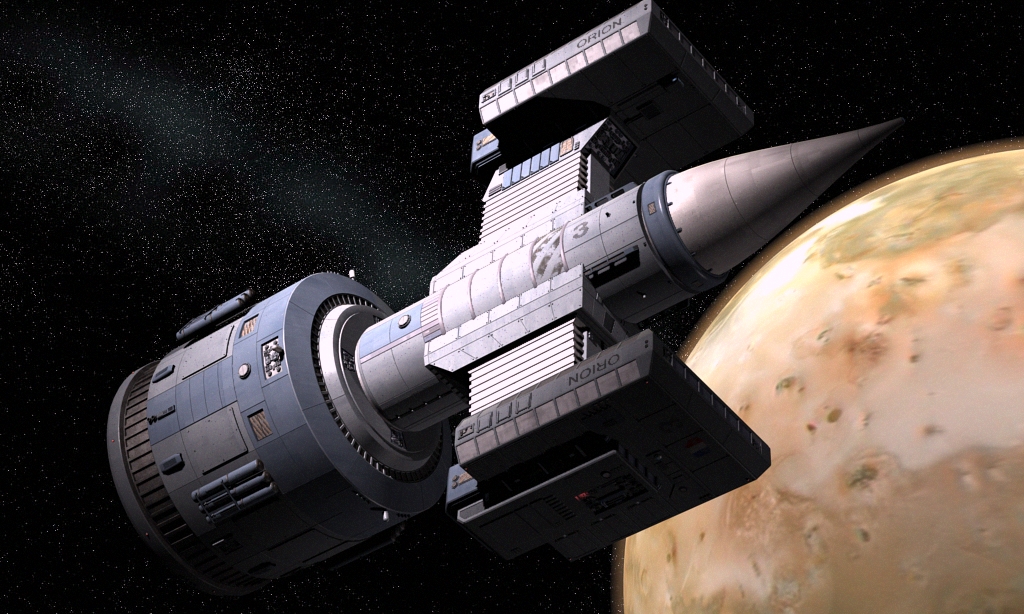
|
France France purchased no fewer than six CESACs for service with the MSF as the Constellation Class. The CESAC emerged at a somewhat embarrassing time for the MSF following the dramatic cost overruns on the innovative Ypres Class ‘frigates’. These overruns had bitten into the procurement budget which the revolving door governments of the 12th Republic were unwilling to refill. The MSF were more than willing to accept a mostly French CESAC following the success of the CESAD. The French CESACs were christened Herakles, Hydre, Persée, Cassiopée, Orion and Sagittaire. These were commissioned from 2262 onwards with the last entering service in 2271. The Constallations were widely deployed around France’s colonial holdings as well as forming a key element to the core fleets’ striking power. The first Herakles was involved in MSF operations during the Canton-Indonesia War to escort merchant shipping moving from the core to the Chinese Arm from Indonesian space force and privateer operations. Famously the ship was involved in the capture of the Q-Ship privateer Brisbane Express in the last year of the war. All the ships saw service in similar operations during the 3rd Rio Plato War. The Constellations were the backbone of the French cruiser fleet during the Central Asian War, supplemented by the first of the new Suffrens. Given the superior force projection capabilities of the Suffrens the Constellations saw most of their service in the core worlds and saw frequent combat against Manchurian raiders and blockade runners. The Cassiopée was destroyed by the Manchurian main force on the Chinese Arm in the last year of the war, an event which triggered a major MSF incursion into the arm. The Constellations began to be retired following the Central Asian War, Herakles was scrapped and Hydre sold onwards. The remaining ships were retrained due to the rise in tensions with the German States, Persée was later crippled in an ambush by DSKM raiders in the outer Sol system. Efforts were made to salvage the ship, but she too was scrapped and the drive coils recovered. Orion and Sagittaire remain in service with the French 1st and 2nd Fleets. They have been upgraded with new avionics and missiles and although due for retirement they have been kept on to allow the MSIF to send more modern warships to the front against the Kafers. It is not yet known if they will be kept on as more Vengeur Class cruisers are completed or if they will be sold on to a French ally, perhaps Freihafen, or simply scrapped. Britain The
RSN was rather more enthusiastic about the CESAC than the CESAD, at
the time it was making do with the stately, if pedestrian Vanguard Class
dating from the 2230s. The RSN’s development budget was tied up in the
Dreadnought project and the Future Fleet Battle Ship or Revenge
Class was some way in the future. For the RSN the CESAC was a cheap
way to bridge a self evident capability gap. The British purchased three CESACs commissioned as the Vian, Cunningham and Summerville. The naming of the CESACs was, like that of the CESADs, widely remarked on in the press. The RSN’s media operations team merely remarked that they were honouring oft overlooked WW2 commanders, although once again Parliamentary Questions were raised on the issue. In
RSN service the CESACs proved to be something of an acquired taste.
Used to the long-legged Vanguards and Devonshires many RSN FBS crews
decried the short range and cramped quarters of the CESACs. However
several key captains championed the CESACs which were robust and capable
of aggressive handling in a close in engagement and the ships became
known as ‘bulldogs’ throughout the service. Like the French the RSN
retained the CESACs mostly within their core based organisations. The
Bulldogs saw service in operations to secure British lines of communication
during times of tension and later saw service on the Chinese Arm at
Clarkestar and Doris at the height of the piracy crisis in that arm
of space. The British CESACs were paid off in the 90s as the King Christian
Class began to enter service. Azania Azania’s purchase of three CESACs represented the acquisition of the largest and most powerful warships yet to see service with the Azanian Space Force. The Cape Town, Johannesburg and Durban were procured in the latter half of the 2260s and together with the CESADs formed the backbone of the ASF’s striking power for the best part of three decades. The lack of a real threat to Azania’s holdings saw the three ships placed in reserve and mothballed from 2295. The
Kafer War however caused a reassessment of the capabilities of the ASF
and the Durban was reactivated in 2299 using parts form the other
two. The Cape Town followed suit in 2301 using spares purchased
from Ukraine. The Durban formed the key part of the Azanian reinforcement
squadron to the French Arm in combination with a number of CESAD destroyers.
Bavaria
– Germany Bavaria bought strongly into the CESAC programme with no fewer than five CESACs being procured in two batches and named Husar, Uhlan, Kürassier, Schützen and Jäger. The BSM’s CESACs played a key role in Bavaria’s prosecution of the Central Asian War. To sustain the colony at Rho Eridani on the Chinese Arm the BSM was forced to dispatch substantial combat groups in order to ensure merchant convoys arrived successfully. Initially the Manchurians only conducted harassing operations against the BSM but these ramped up substantially in 2286 when the Manchurian Main Force mounted a deliberate assault on a Bavarian resupply convoy resulted in the destruction of the entire convoy together with the destroyer Württemberg and a pair of frigates. This debacle resulted in an increasing scale of protection for convoys although in December 2286 a repeat Manchurian attack resulted in the loss of the modern Haupstadt and the Husar. As a result Bavarian convoys were often coordinated with major French incursions into the Chinese Arm by the 5th Fleet and it was standard practise for at least two CESACs to escort each convoy. One of these missions resulted in the scuttling of the Schützen from battle damage following a desperate but successful rearguard action. The crew were rescued by the Manchurians and interned for the rest of the war. The loss of two CESACs and the impending obsolescence of the class caused some dissention in the higher echelons in the ranks of the BSM. Some commanders desired the purchase of some of the excellent French Suffrens whilst others looked to launch a rebuilt CESAC with modern avionics and weaponry. Consequently the Uhlan was withdrawn from service in 2290 and put through a huge refit and plans were laid for the other two survivors to be refitted too. The Germans however had other plans with their robust Hamburg Class and when Reunification occurred many systems destined for the CESACs were used in the Hamburgs instead. Kürassier
was stationed above Tirane and her Captain declared for Germany and
set out for the Sol system and was subsequently destroyed by the French
2nd Fleet. Jäger and Uhlan survived the war but the former
was retired in 2295 with components being used in the continuing Hamburg
building programme. Uhlan remains in service but is used by the
DSKM in a training role in the Sol system but can be retasked very quickly.
Indeed Uhlan was dispatched to Neubayern prior to the Battle
of Beowulf to act as a force of last resort.
Ukraine The Ukraine purchased three CESACs and was again the first nation to launch a CESAC. The idea was to have three CESACs to enable one to be permanently deployed to Eta Bootis in order to defend this expensive colonial effort and another be tasked to OQZ. The three Ukrainian ships were the Konstantine, 22nd of January and Zaporozhian. The ships first saw action during the Central Asian War escorting convoys along the French Arm and warding off Manchurian raiders and privateers. The Ukrainian 3rd Squadron, led by the Zaporozhian was involved in operations onto the Chinese Arm in 2286 and ’87 with the French 5th Fleet. The Kafer War saw the Konstantine become one of humanities most famous warships under its commander Sergei Borodin. It was almost constantly engaged in action over the course of five years, being damaged on numerous occasions before returning to Earth late in 2303 to a hero’s welcome. The 22nd of January together with smaller ships led the 3rd Squadron, Ukraine’s contribution to the Reserve Fleet at the Battle of Beowulf and subsequently replaced Konstantine at Eta Bootis. Ukraine has upgraded its CESACs throughout their service and intends to keep them in service although is looking to introduce a replacement class in the near future. Ukraine has a small but thriving business producing spare parts for various CESAC operators. Other Nations The CESACs were somewhat less successful ‘second hand’ purchases than the CESADs, mainly as they are much more expensive to operate than their smaller cousins. However several smaller nations have operated hand-me-down CESACs or a small number of new build ships. Today there are less than a handful of these CESACs in operation.
Below:
Konstantine
on arrival at Eta Bootis in 2297.
|
